instrument panel PEUGEOT 4C 2015 Owners Manual
[x] Cancel search | Manufacturer: PEUGEOT, Model Year: 2015, Model line: , Model:Pages: 348, PDF Size: 3.76 MB
Page 3 of 348

TABLE OF CONTENTSSECTIONPAGE
1INTRODUCTION ...............................................................3
2THINGS TO KNOW BEFORE STARTING YOUR VEHICLE..................................9
3UNDERSTANDING THE FEATURES OF YOUR VEHICLE..................................73
4UNDERSTANDING YOUR INSTRUMENT PANEL......................................109
5STARTINGANDOPERATING ....................................................151
6WHATTODOINEMERGENCIES..................................................225
7MAINTAININGYOURVEHICLE...................................................247
8MAINTENANCE SCHEDULES.....................................................311
9IF YOU NEED CONSUMER ASSISTANCE............................................321
10INDEX .....................................................................331
1
2
3
4
5
6
7
8
9
10
Page 9 of 348
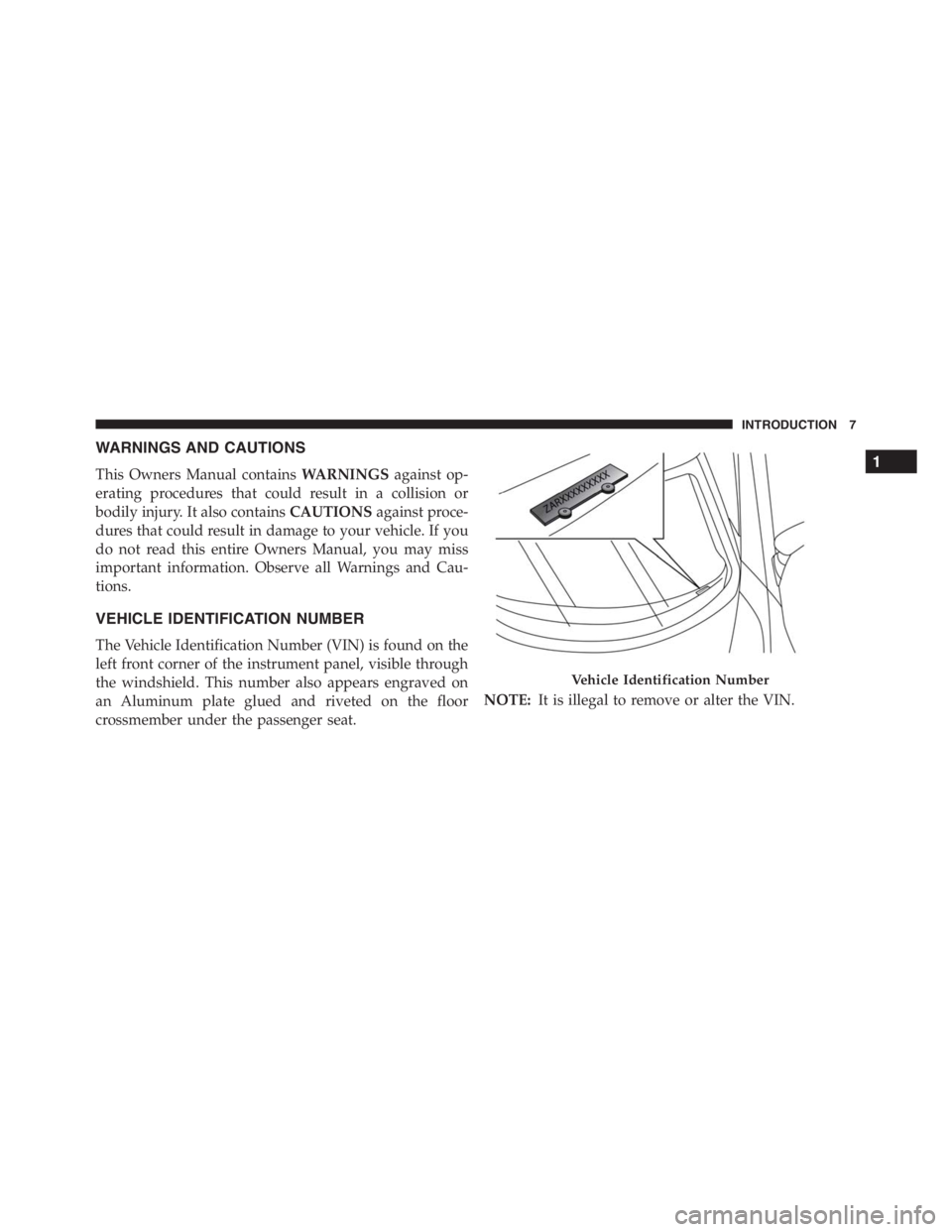
WARNINGS AND CAUTIONS
This Owners Manual containsWARNINGSagainst op-
erating procedures that could result in a collision or
bodily injury. It also containsCAUTIONSagainst proce-
dures that could result in damage to your vehicle. If you
do not read this entire Owners Manual, you may miss
important information. Observe all Warnings and Cau-
tions.
VEHICLE IDENTIFICATION NUMBER
The Vehicle Identification Number (VIN) is found on the
left front corner of the instrument panel, visible through
the windshield. This number also appears engraved on
an Aluminum plate glued and riveted on the floor
crossmember under the passenger seat.NOTE:It is illegal to remove or alter the VIN.
Vehicle Identification Number
1
INTRODUCTION 7
Page 18 of 348

NOTE:
•The engine locking function is guaranteed by the Alfa
Romeo CODE, which is automatically activated when
the key is extracted from the ignition switch.
•The alarm is adapted to meet requirements in various
countries.
To Arm The System
With the doors and decklid closed and the ignition key
either turned to STOP or removed, point the key towards
the vehicle then push and release the lock button.
The system emits an acoustic and visual signal and
activates door locking.
A self-diagnosis stage lasting approximately 30 seconds
precedes the activation of the alarm. During the self-
diagnosis, the vehicle security light flashes in the instru-
ment panel at a frequency of about one flash per second.After the self-diagnosis stage, the vehicle security light
flashes at a lower frequency (approximately one flash
every three seconds).
If, after the alarm is switched on, a second acoustic signal
is emitted and/or a visual signal via the vehicle security
light in the instrument panel, wait about four seconds
and switch off the alarm by pushing the lock button,
check that the doors and decklid are closed correctly and
then reactivate the system by pushing the unlock button.
If the alarm emits an acoustic signal even when the doors
and decklid are closed correctly, a system malfunction
has occurred: in this case, contact a dedicated Alfa Romeo
Dealership.
16 THINGS TO KNOW BEFORE STARTING YOUR VEHICLE
Page 20 of 348

If a perimeter violation triggers the security system, the
siren will sound for 30 seconds and the exterior lights
will flash followed by approximately five seconds of no
activity. This will continue for eight cycles if no action is
taken to disarm the system.
The alarm takes approximately 20 seconds to arm once
the doors are locked with the key fob and once armed,
the LED indicator on the dash will blink whenever the
system is armed. If motion is detected during the arming
period, the motion detection system is disabled.
To ensure the correct operation of the protection, com-
pletely close the side windows. If a perimeter violation
triggers the security system, the siren will sound and the
exterior lights will flash.
To disable the volumetric protection, turn the ignition
key from STOP to MAR-ON twice in a row, then activate
the alarm within 15 seconds, pushing the lock button onthe remote control. When the function is deactivated, this
is indicated by the vehicle security light in the instrument
panel flashing for several seconds.
To disable the anti-lift protection, the ignition key must
be turned from STOP to MAR-ON three times in a row,
followed by activating the alarm within 15 seconds,
pushing the lock button on the remote control.
When the function is deactivated, this is indicated by the
vehicle security light in the instrument panel flashing for
several seconds.
Any disabling of the volumetric/anti-lift protection must
be repeated each time the instrument panel is switched
off.
18 THINGS TO KNOW BEFORE STARTING YOUR VEHICLE
Page 22 of 348

NOTE:The line of transmission must not be blocked
with metal objects.
To Unlock The Doors
Push and release the UNLOCK button on the RKE
transmitter to unlock the doors. The park lights and turn
signal lights will flash to acknowledge the signal and the
illuminated entry system will turn on.
NOTE:The Door Unlock Indicator will illuminate in the
instrument panel when one or both doors are unlocked.
To Lock The Doors
Push and release the LOCK button on the RKE transmit-
ter: locking of doors, switching off of internal roof light
and single flashing of direction indicators.
If one or more door are open, the doors will not be
locked. This is indicated by a rapid flashing of the
direction indicators. The doors will be locked if the
decklid is open however.
When a speed of more than 12 mph (20 km/h) is reached,
the doors will be locked automatically if the Autoclose
Key Fob
1 — Vehicle Key
2 — Push To Open/Close Vehicle Key 20 THINGS TO KNOW BEFORE STARTING YOUR VEHICLE
Page 46 of 348

WARNING!(Continued)
•Do not use the Automatic Locking Mode to restrain
occupants who are wearing the seat belt or children
who are using booster seats. The locked mode is
only used to install rear-facing or forward-facing
child restraints that have a harness for restraining
the child.
Supplemental Restraint System (SRS)
Air Bag System Components
Your vehicle may be equipped with the following air bag
system components:
•Occupant Restraint Controller (ORC)
•Air Bag Warning Light
•Steering Wheel and Column
•Instrument Panel•Knee Impact Bolsters
•Advanced Front Air Bags
•Supplemental Side Air Bags
•Supplemental Driver Knee Air Bag
•Front and Side Impact Sensors
•Front Seat Belt Pretensioners, Seat Belt Buckle Switch,
and Seat Track Position Sensors
Advanced Front Air Bags
This vehicle has Advanced Front Air Bags for both the
driver and front passenger as a supplement to the seat
belt restraint systems. The driver’s Advanced Front Air
Bag is mounted in the center of the steering wheel. The
passenger’s Advanced Front Air Bag is mounted in the
instrument panel. The words AIRBAG are embossed on
the air bag covers.
44 THINGS TO KNOW BEFORE STARTING YOUR VEHICLE
Page 47 of 348
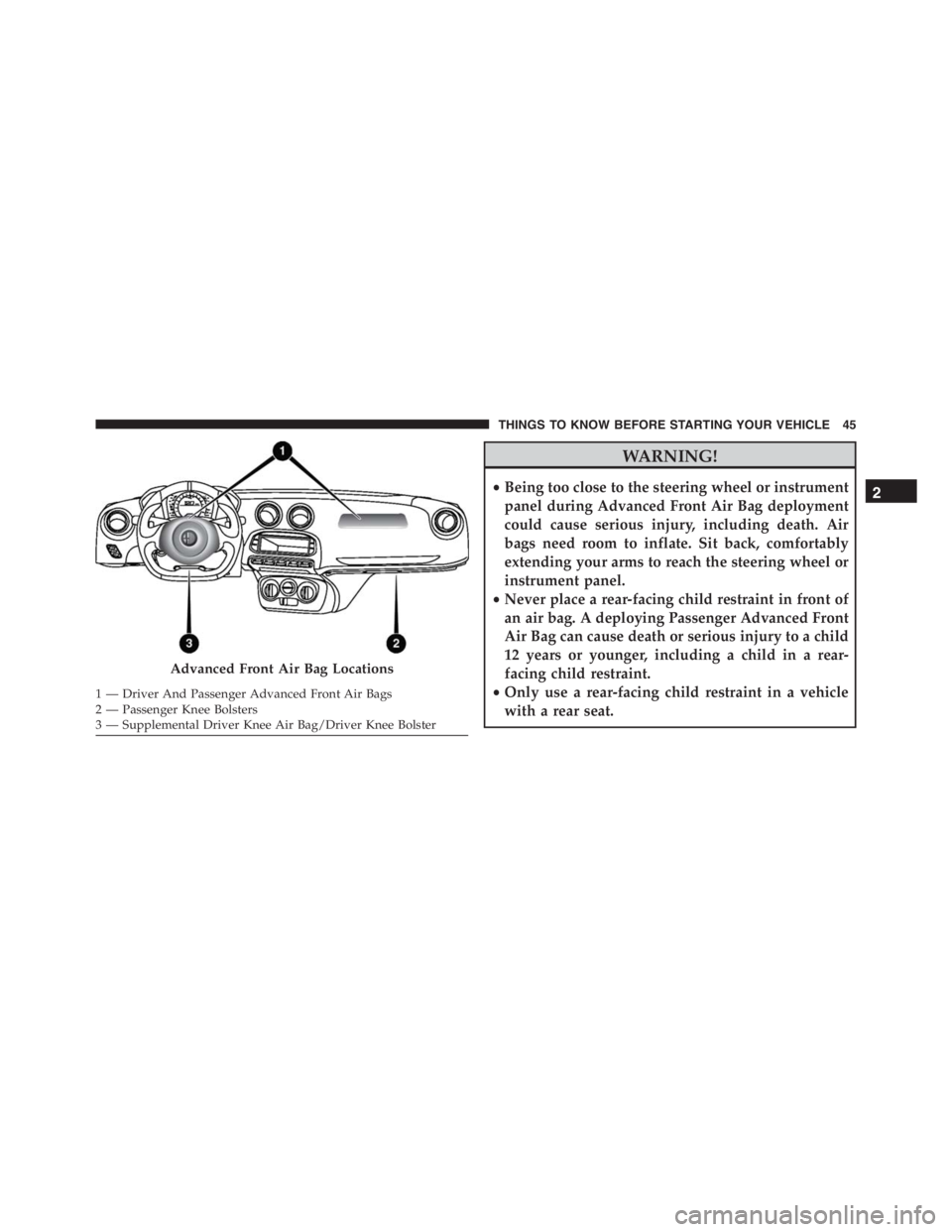
WARNING!
•Being too close to the steering wheel or instrument
panel during Advanced Front Air Bag deployment
could cause serious injury, including death. Air
bags need room to inflate. Sit back, comfortably
extending your arms to reach the steering wheel or
instrument panel.
•Never place a rear-facing child restraint in front of
an air bag. A deploying Passenger Advanced Front
Air Bag can cause death or serious injury to a child
12 years or younger, including a child in a rear-
facing child restraint.
•Only use a rear-facing child restraint in a vehicle
with a rear seat.
Advanced Front Air Bag Locations
1 — Driver And Passenger Advanced Front Air Bags
2 — Passenger Knee Bolsters
3 — Supplemental Driver Knee Air Bag/Driver Knee Bolster
2
THINGS TO KNOW BEFORE STARTING YOUR VEHICLE 45
Page 48 of 348
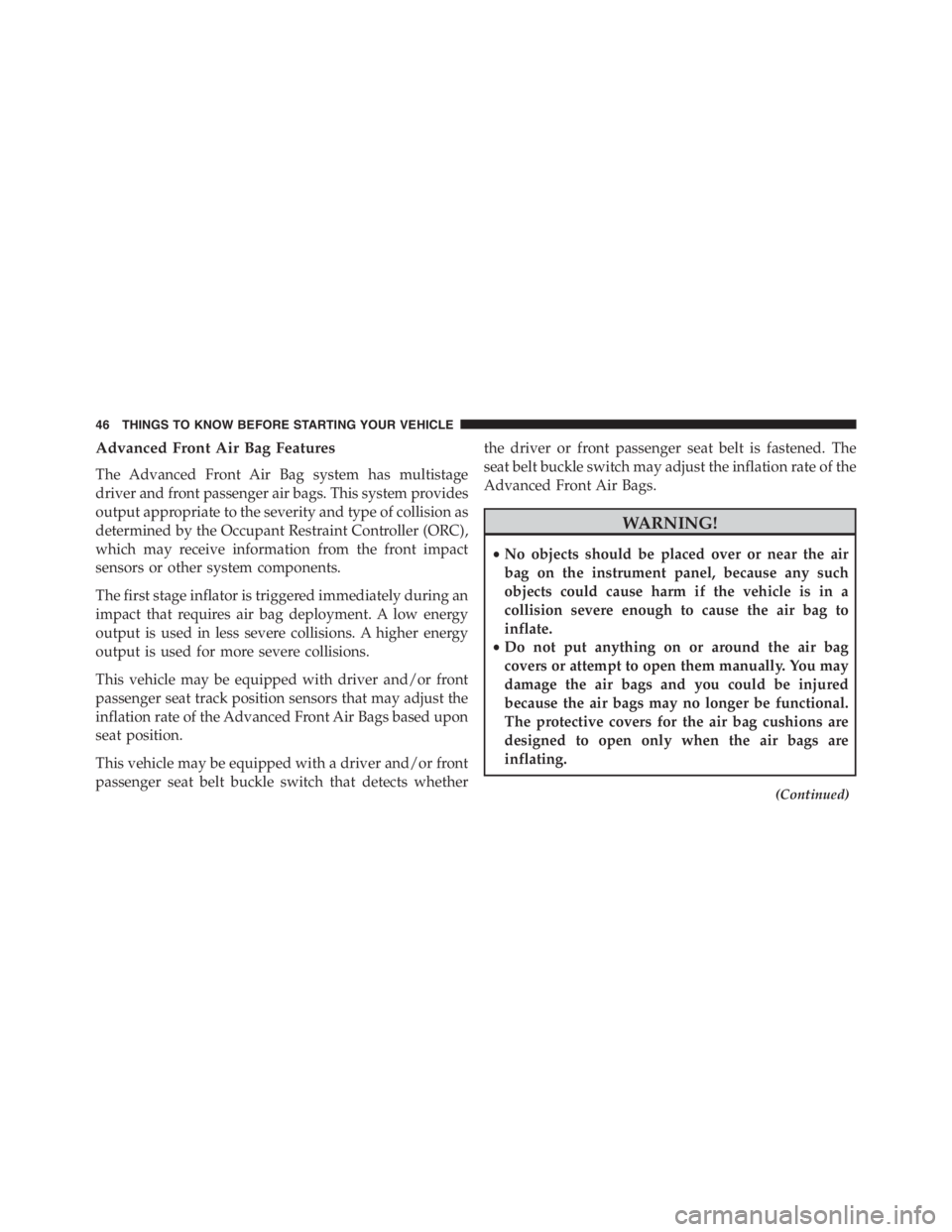
Advanced Front Air Bag Features
The Advanced Front Air Bag system has multistage
driver and front passenger air bags. This system provides
output appropriate to the severity and type of collision as
determined by the Occupant Restraint Controller (ORC),
which may receive information from the front impact
sensors or other system components.
The first stage inflator is triggered immediately during an
impact that requires air bag deployment. A low energy
output is used in less severe collisions. A higher energy
output is used for more severe collisions.
This vehicle may be equipped with driver and/or front
passenger seat track position sensors that may adjust the
inflation rate of the Advanced Front Air Bags based upon
seat position.
This vehicle may be equipped with a driver and/or front
passenger seat belt buckle switch that detects whetherthe driver or front passenger seat belt is fastened. The
seat belt buckle switch may adjust the inflation rate of the
Advanced Front Air Bags.
WARNING!
•No objects should be placed over or near the air
bag on the instrument panel, because any such
objects could cause harm if the vehicle is in a
collision severe enough to cause the air bag to
inflate.
•Do not put anything on or around the air bag
covers or attempt to open them manually. You may
damage the air bags and you could be injured
because the air bags may no longer be functional.
The protective covers for the air bag cushions are
designed to open only when the air bags are
inflating.
(Continued)
46 THINGS TO KNOW BEFORE STARTING YOUR VEHICLE
Page 49 of 348
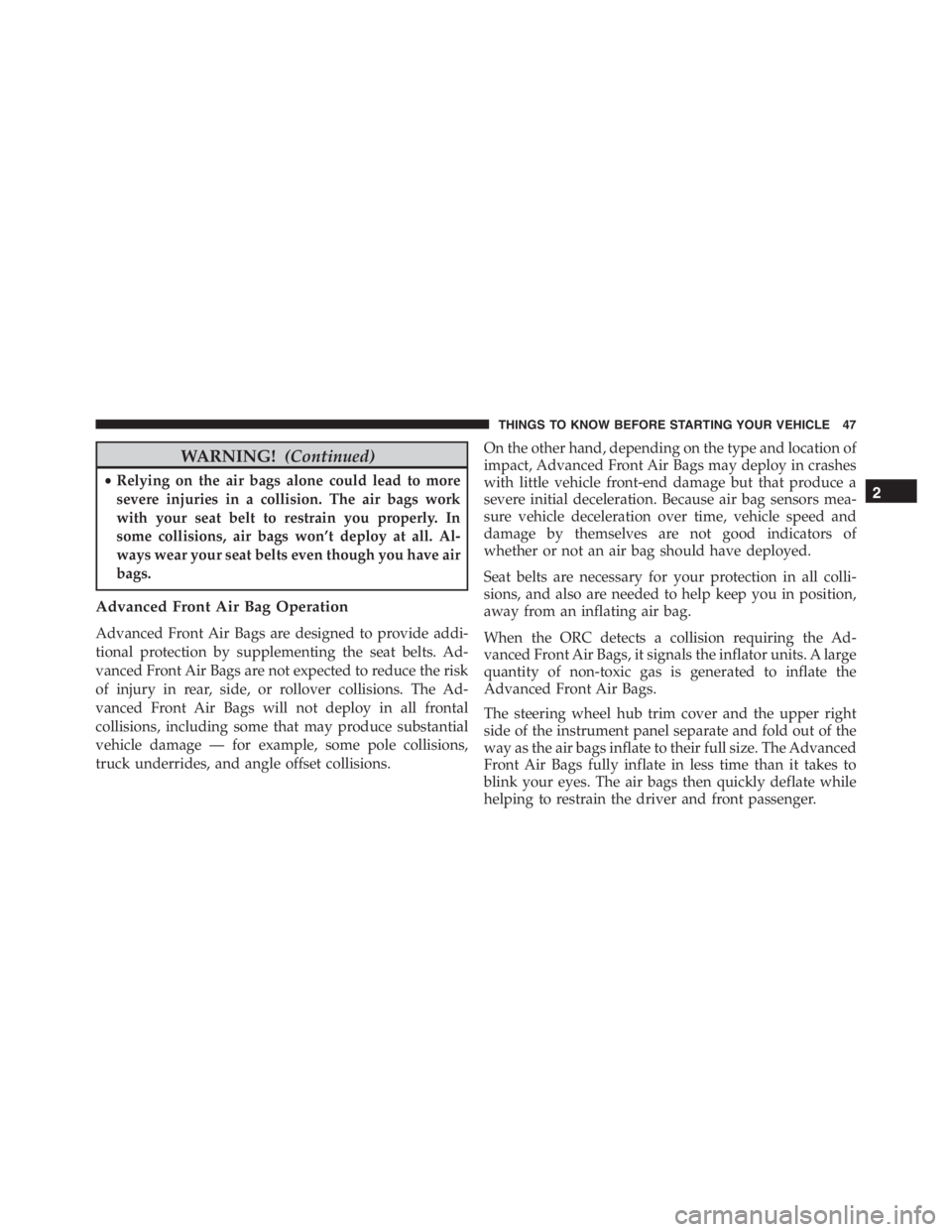
WARNING!(Continued)
•Relying on the air bags alone could lead to more
severe injuries in a collision. The air bags work
with your seat belt to restrain you properly. In
some collisions, air bags won’t deploy at all. Al-
ways wear your seat belts even though you have air
bags.
Advanced Front Air Bag Operation
Advanced Front Air Bags are designed to provide addi-
tional protection by supplementing the seat belts. Ad-
vanced Front Air Bags are not expected to reduce the risk
of injury in rear, side, or rollover collisions. The Ad-
vanced Front Air Bags will not deploy in all frontal
collisions, including some that may produce substantial
vehicle damage — for example, some pole collisions,
truck underrides, and angle offset collisions.On the other hand, depending on the type and location of
impact, Advanced Front Air Bags may deploy in crashes
with little vehicle front-end damage but that produce a
severe initial deceleration. Because air bag sensors mea-
sure vehicle deceleration over time, vehicle speed and
damage by themselves are not good indicators of
whether or not an air bag should have deployed.
Seat belts are necessary for your protection in all colli-
sions, and also are needed to help keep you in position,
away from an inflating air bag.
When the ORC detects a collision requiring the Ad-
vanced Front Air Bags, it signals the inflator units. A large
quantity of non-toxic gas is generated to inflate the
Advanced Front Air Bags.
The steering wheel hub trim cover and the upper right
side of the instrument panel separate and fold out of the
way as the air bags inflate to their full size. The Advanced
Front Air Bags fully inflate in less time than it takes to
blink your eyes. The air bags then quickly deflate while
helping to restrain the driver and front passenger.
2
THINGS TO KNOW BEFORE STARTING YOUR VEHICLE 47
Page 52 of 348
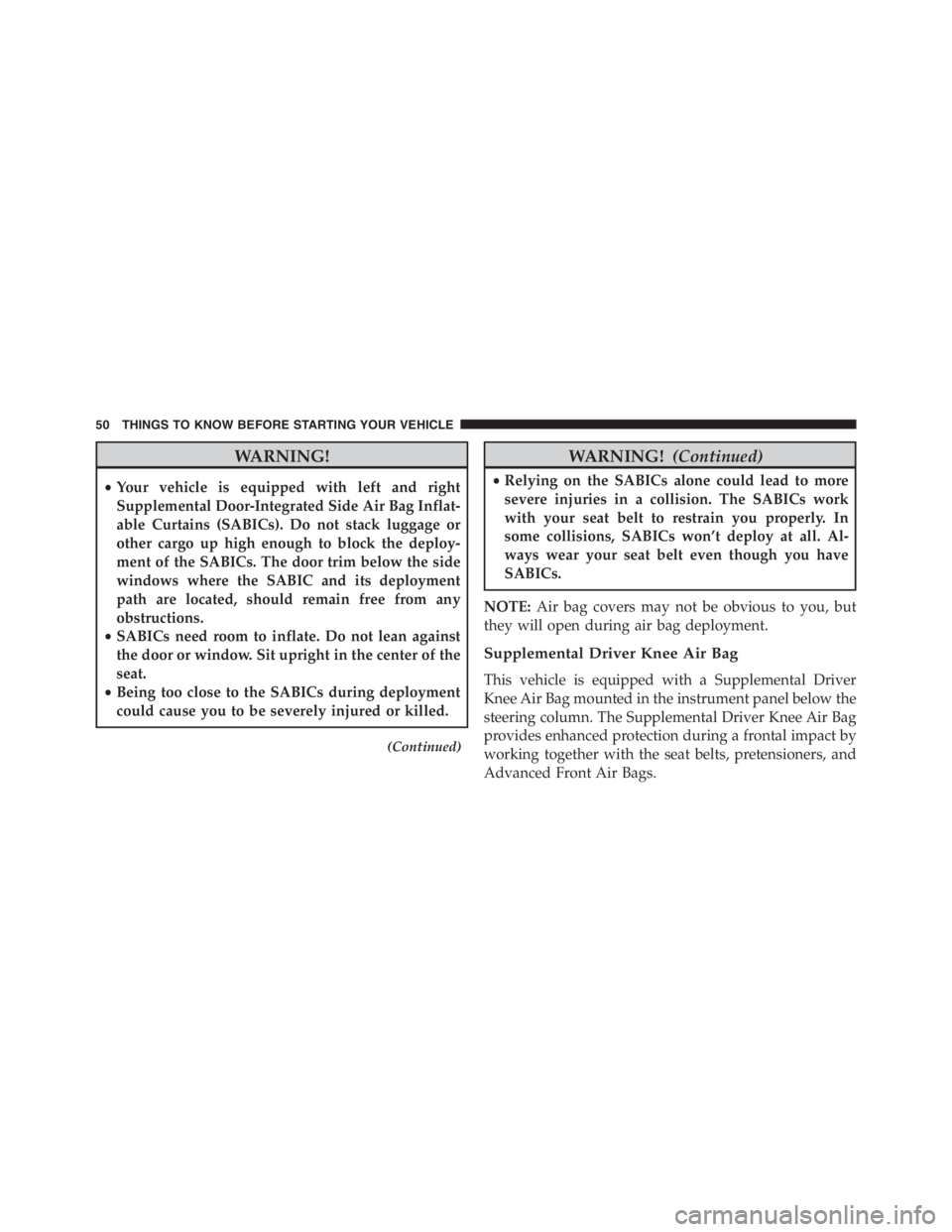
WARNING!
•Your vehicle is equipped with left and right
Supplemental Door-Integrated Side Air Bag Inflat-
able Curtains (SABICs). Do not stack luggage or
other cargo up high enough to block the deploy-
ment of the SABICs. The door trim below the side
windows where the SABIC and its deployment
path are located, should remain free from any
obstructions.
•SABICs need room to inflate. Do not lean against
the door or window. Sit upright in the center of the
seat.
•Being too close to the SABICs during deployment
could cause you to be severely injured or killed.
(Continued)
WARNING!(Continued)
•Relying on the SABICs alone could lead to more
severe injuries in a collision. The SABICs work
with your seat belt to restrain you properly. In
some collisions, SABICs won’t deploy at all. Al-
ways wear your seat belt even though you have
SABICs.
NOTE:Air bag covers may not be obvious to you, but
they will open during air bag deployment.
Supplemental Driver Knee Air Bag
This vehicle is equipped with a Supplemental Driver
Knee Air Bag mounted in the instrument panel below the
steering column. The Supplemental Driver Knee Air Bag
provides enhanced protection during a frontal impact by
working together with the seat belts, pretensioners, and
Advanced Front Air Bags.
50 THINGS TO KNOW BEFORE STARTING YOUR VEHICLE